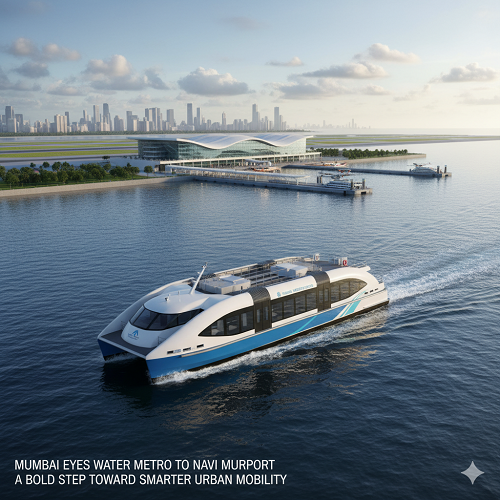
India’s Real Estate Set to Touch $10 Trillion by 2047, Driven by Tier-II Cities, Infrastructure, and Green Growth, Colliers–CII Report
India’s real estate sector stands on the threshold of an unprecedented transformation. According to a new report by Colliers and the Confederation of Indian Industry (CII), the market is poised to expand nearly twentyfold, from its current value of around USD 0.3 trillion to between USD 5 trillion and USD 10 trillion by 2047. This surge positions real estate as a core driver of India’s economic evolution under the Viksit Bharat vision, potentially contributing up to 20% of the national GDP.
The report, titled “Real Estate @2047: Building India’s Future Growth Corridors,” emphasizes that the next two decades will redefine how India builds, lives, and works. With rapid urbanization, infrastructure expansion, demographic shifts, and technological integration, the sector is moving from a fragmented market to a structured, innovation-led ecosystem.
The Scale of Transformation
India’s current real estate market, valued at around USD 0.3 trillion, has already shown consistent double-digit growth across housing, office, and industrial segments. The Colliers–CII report suggests that by 2047, real estate will not only multiply in size but also in complexity, evolving into a diversified landscape that includes traditional sectors as well as new-age assets such as data centers, senior living, and co-living spaces.
The report forecasts India’s annual office demand to stabilize between 70 and 75 million sq ft in the coming years, while industrial and warehousing requirements are expected to reach 30 to 40 million sq ft annually. These projections underscore a broad-based expansion driven by both corporate growth and consumer demand.
“India’s real estate journey towards 2047 will be powered by tech adoption and inclusive growth,” said Pradeep Aggarwal, Chairman of Signature Global India. “Policy initiatives like RERA, PMAY, and infrastructure status for affordable housing have strengthened transparency and financing, enabling developers to scale efficiently.”
Tier-II Cities, The Next Growth Frontier
While metros like Mumbai, Delhi-NCR, and Bengaluru will continue to dominate in terms of scale, the real growth story is now shifting toward India’s Tier-II and Tier-III cities. The Colliers–CII report identifies cities such as Kochi, Lucknow, Chandigarh, and Thiruvananthapuram as emerging engines of real estate expansion.
“Expressways and industrial corridors are enhancing connectivity, creating viable economic hotspots, and fuelling urban development,” said Harleen Kaur, Deputy Secretary, Ministry of Road Transport and Highways. “Infrastructure expansion is unlocking new growth corridors and transforming smaller cities into integrated, investment-ready ecosystems.”
Improved transport connectivity, airport development, and the rise of remote working hubs have collectively made these cities more attractive for both residential and commercial investments. Over the next two decades, Tier-II cities are expected to account for more than 40% of new real estate supply, supported by affordable land, skilled labor, and expanding digital infrastructure.
Urbanization and the Rise of the New Indian City
India’s urbanization rate is expected to surge sharply, with nearly 40% of the population living in urban centers within the next few years. This demographic shift is driving unprecedented demand for housing, logistics, and sustainable infrastructure.
As nearly 100 new million-plus population cities emerge, the urban real estate ecosystem will evolve into a complex web of integrated corridors combining housing, workspaces, recreation, and technology. “As nearly 100 million-plus cities rise, real estate corridors will evolve into inclusive, resilient, and tech-driven ecosystems,” noted Badal Yagnik, CEO and MD of Colliers India.
This transformation will not only reshape city skylines but also redefine how real estate contributes to the economy, creating millions of jobs across construction, manufacturing, logistics, and allied industries.
Green and Digital Infrastructure, The Twin Growth Drivers
Sustainability has shifted from being a buzzword to a business imperative. Green building certifications, energy-efficient designs, and renewable integration are now influencing investor decisions and tenant preferences alike.
According to Colliers–CII, India’s infrastructure development strategy is increasingly focusing on low-carbon growth. The National Infrastructure Pipeline (NIP) and Gati Shakti initiatives have catalyzed investments across logistics, transportation, and energy-efficient construction. This approach ensures that India’s real estate boom remains both environmentally responsible and economically inclusive.
At the same time, digital infrastructure, from 5G networks to data centers, is emerging as a parallel growth engine. The report highlights how the rapid adoption of PropTech (property technology) is improving efficiency across project management, financing, and customer engagement.
The alternative asset segment, including data centers, co-living, student housing, and senior living, is projected to expand at a compounded annual growth rate (CAGR) of 20 to 25% through 2030. These asset classes will help diversify the market and attract institutional investors seeking stable, long-term returns.
Policy Support and Financing Reform
Regulatory and policy measures have played a pivotal role in stabilizing India’s real estate market. Reforms such as the Real Estate (Regulation and Development) Act (RERA) have enhanced transparency and accountability. The government’s Pradhan Mantri Awas Yojana (PMAY) continues to drive mass housing development, while infrastructure status for affordable housing has encouraged banks and financial institutions to extend long-term credit.
With Real Estate Investment Trusts (REITs) gaining traction, India’s commercial property segment has opened up to a wider pool of institutional investors, further deepening market liquidity. The growing participation of private equity funds and sovereign wealth funds is expected to inject over USD 25 to 30 billion into the sector by 2030.
Toward a $10 Trillion Vision
India’s real estate sector is not merely expanding, it is evolving into a structured and resilient growth engine. The Colliers–CII report envisions a future where housing demand, infrastructure investment, and sustainability converge to create cities that are smarter, greener, and more inclusive.
By 2047, real estate could account for one-fifth of India’s GDP, generating massive employment opportunities and supporting the broader Amrit Kaal vision of economic self-reliance and prosperity.
As India accelerates toward its centenary of independence, the sector’s growth story is likely to mirror the nation’s own transformation, bold, diverse, and future-ready. With Tier-II cities emerging as new economic anchors and sustainability shaping every brick and blueprint, India’s real estate is not just building homes and offices, it’s building the foundation of Viksit Bharat.



